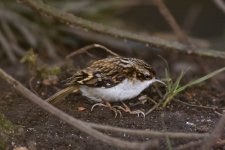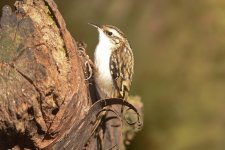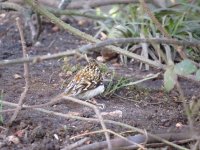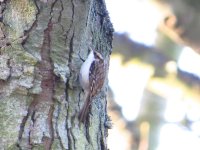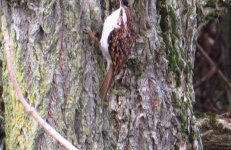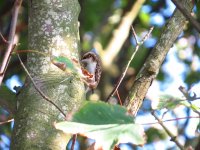Brett Richards
Well-known member

Attached are two of Andy Hood’s photos and one of mine of the probable Northern Treecreeper present at Danes Dyke, Flamborough, from at least 14 February. Not a classic Northern; The supercilium is poor in front of the eye, and is widest over the eye instead of flaring at the rear, and the pale markings on the secondaries and most of the primary markings are pale yellowish rather than whitish, with only the outer three primaries having whitish fringes. The third image (mine) is obviously overexposed, but nevertheless could a British bird ever give this impression?
Over the years I have had three other candidate Northerns (photos attached to next post), but the trouble with watching at Flamborough is that any Treecreeper I see, especially in autumn or winter could be a Northern, so it is difficult to determine the limits of variability in British birds. I imagine the likelihood of a Northern turning up inland, especially in the west, would be much smaller than at Flamborough, so anyone who has studied Treecreepers inland should have a better idea of the variability of British birds. Features of all the birds in the attached photos in this and the next post which have been suggested as good for Northern include whitish crown streaking as opposed to pale brown in British birds (but this is contra what is written in Birding Frontiers here http://birdingfrontiers.com/2014/01/15/northern-treecreeper) and pale shafts of the tail feathers (as opposed to dark brown), as well of course as the white markings on the upperparts and whitish rear flanks with just a faint brown suffusion.
Can anyone say if any or all of these birds are within the range of variability of British birds?
Brett
Over the years I have had three other candidate Northerns (photos attached to next post), but the trouble with watching at Flamborough is that any Treecreeper I see, especially in autumn or winter could be a Northern, so it is difficult to determine the limits of variability in British birds. I imagine the likelihood of a Northern turning up inland, especially in the west, would be much smaller than at Flamborough, so anyone who has studied Treecreepers inland should have a better idea of the variability of British birds. Features of all the birds in the attached photos in this and the next post which have been suggested as good for Northern include whitish crown streaking as opposed to pale brown in British birds (but this is contra what is written in Birding Frontiers here http://birdingfrontiers.com/2014/01/15/northern-treecreeper) and pale shafts of the tail feathers (as opposed to dark brown), as well of course as the white markings on the upperparts and whitish rear flanks with just a faint brown suffusion.
Can anyone say if any or all of these birds are within the range of variability of British birds?
Brett




